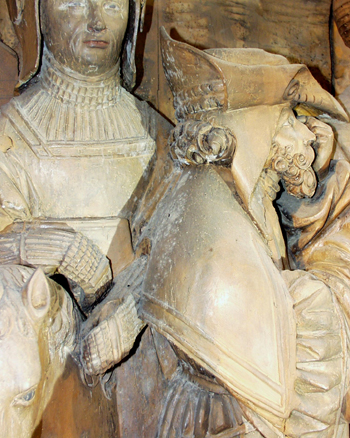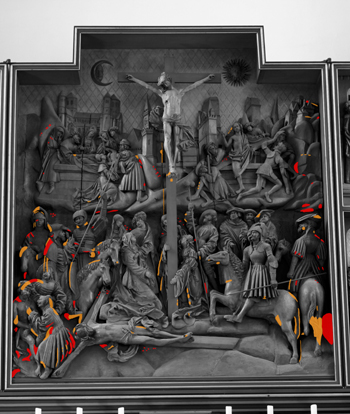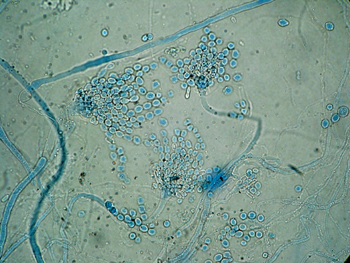Hochschularbeit
| Inga Blohm: | The wooden interior in the St. Magdalene Church in Hildesheim. Causes of infestation of the Aspergillus glaucus. | Zurück |
| Sprache: | Original - Übersetzung | |
| Seitenübersicht: |
|
|
 Infestation of mould of the Aspergillus glaucus at the altar relief.
|
|
 A map of infestation size at the altar. (red - viewable; orange - concealed)
|
|
| Zusammenfassung: | An active infestation of mould of the Aspergillus glaucus i.e. Eurotium herbariorum type has been proven to exist in the St. Magdalene Church (St. Magdalenenkirche) in Hildesheim. The mould can be found on the all existing materials within the church. In this study the cause of the present infestation is being examined on the basis of objects with wooden surfaces. Growth of mould is subject to various influencing factors. Apart from climatic conditions such as room temperature, relative humidity, surface temperature and humidity of material, i.e. humidity of the substrate, the supply of nutrients plays an important role. To fully understand the cause of the infestation it is therefore necessary to closely observe the life cycle of Aspergillus glaucus in situ as well as in laboratory test. This is done by analysing the substrate and by measuring the climate conditions, the activity of the infestation and the concentration of spores in the air. By recreating the determined factors and prerequisites relevant for growth in the laboratory, the parameters of growth of the Aspergillus glaucus can be researched. In addition the pathogenic potential, i.e. the development of Mykotoxin is being examined. Based on the findings of the research this study lists recommendations regarding treatment of mould infested objects, prevention of re-infection as well as the handling of risk potential for humans in the interior of the church. |
| Schlagworte: | aspergillus glaucus, eurotium herbariorum, mould, mycotoxine |
 conidiophores and conida of the Aspergillus glaucus.
|
|
| weitere Angaben: |
|
| Kontakt: |
Inga Blohm Am Domänenhof 3a Blohm & Tillwick GbR Diplom Restauratoren (FH) 21337 Lüneburg inga.blohm@[Diesen Teil loeschen]web.de www.blohm-tillwick.de |
Das Hornemann Institut verfügt ausschließlich über die hier angezeigten Informationen. Für weitere Informationen oder Kopien der Hochschularbeit wenden Sie sich bitte an den Autor/die Autorin - oder wenn kein Kontakt angegeben ist - an die Sekretariate der jeweiligen Fakultäten.